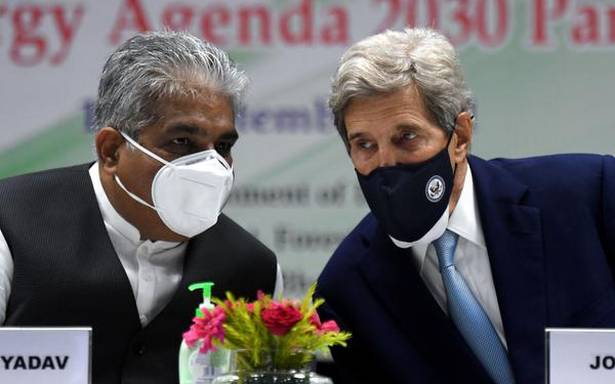U.S. Climate envoy Kerry in Delhi, meets Environment Minister Yadav
The United States is to collaborate with India to work towards installing 450 GW of renewable energy by 2030.
“We look forward to partnering with India in bringing finance, technology and other elements needed to achieve it,” said John Kerry, United States Special Presidential Envoy for Climate, on Monday.
Currently India’s installed power capacity is projected to be 476 GW by 2021-22 and is expected to rise to at least 817 GW by 2030.
Mr. Kerry is on an official visit to India from September 12-14 and is meeting ministers and industrialists to “raise global climate ambition and speed India’s clean energy transition,” according to a communique from the U.S. State Department.
Mr. Kerry was speaking at a public function following a bilateral meeting with Union Environment Minister Bhupender Yadav, at the launch of the Climate Action and Finance Mobilization Dialogue (CAFMD). This was one of the main tracks of the U.S.-India Agenda 2030 Partnership that President Biden and Prime Minister Modi announced at the Leaders Summit on Climate in April 2021.
Mr. Kerry said that Monday’s dialogue would serve as a “powerful avenue” for U.S.-India collaboration and would have three pillars: One would be a “climate action pillar” which would have joint proposals looking at ways in emissions could be reduced in the next decade. The second pillar would be setting out a roadmap to achieving the 450GW in transportation, buildings and industry. The final pillar, or the ”Finance Pillar” would involve collaborating on attracting finance to deploy 450 GW of renewable energy and demonstrate at scale clean energy technologies. Six banks in the U.S., Mr. Kerry said, have already committed to “investing” $4.5 trillion in the next decade towards clean energy.
Following his meeting, Mr. Yadav tweeted: “CAFMD will provide both countries an opportunity to renew collaborations on climate change while addressing financing aspects and deliver climate finances primarily as grants and concessional finance as envisaged under the Paris Agreement.”
A key mission of Mr. Kerry is to build global support for ‘Net Zero’, or carbon neutrality, which is when more carbon is sucked out from the atmosphere or prevented from being emitted than what a country emits and is critical to ensuring that the planet doesn’t heat up an additional half a degree by 2100.
“We have to reach a net zero global standard by 2050. This is not a matter of politics or ideology but one of arithmetic and physics,” said Mr. Kerry.
A major theme building ahead of the climate talks in Glasgow, Scotland, this November is the question of how many nations can commit to a net zero target and by when. A little over 120 countries have committed, with varying degrees of firmness, to reaching carbon neutrality by 2050. Five countries have net zero pledges set for after 2050, including Australia and Singapore, which haven’t set a firm target yet.
The United States has set a target of halving pollution by 2030 from 2005 levels towards the net zero target. President Joe Biden has also committed to phasing out the use of fossil fuel by 2035 for power generation.
India has so far abstained from committing to a net zero goal but is on a climate pathway that is compatible with keeping global temperatures to below 2C by the end of the century. On the other hand, current commitments by the U.S. and Europe, according to analysts T. Jayaraman and Tejal Kanitkar, see them occupy more than their fair share of the current available carbon budget given their historical emissions.
India has reportedly installed 100GW of renewable energy and committed to 175GW by 2022, nearly 100GW of which will come from solar power.
Source: Read Full Article

